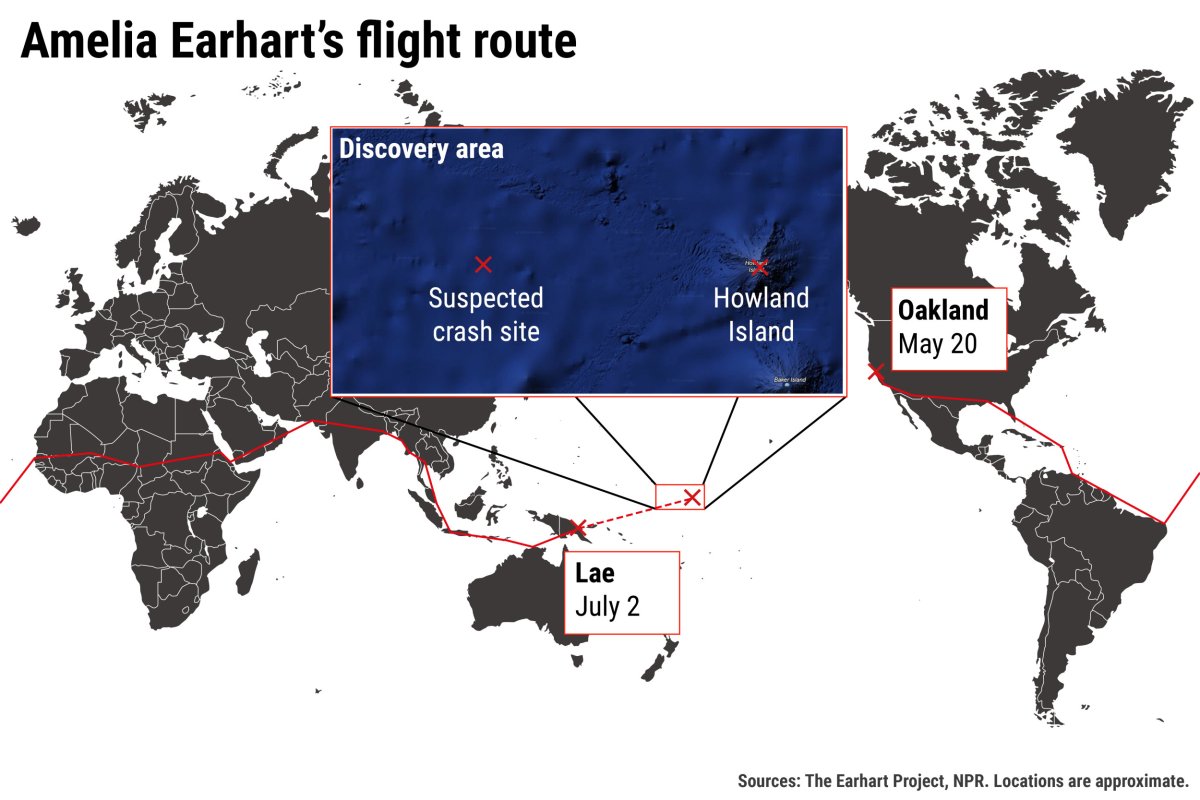A map shows the area of the Pacific Ocean where an explorer claims to have potentially found the missing aircraft piloted by early 20th-century pioneering explorer Amelia Earhart in her fateful attempt to circumnavigate the globe.
Tony Romeo, the founder of ocean exploration company Deep Sea Vision, announced on Monday that sonar imaging of the sea floor near Howland Island—an uninhabited coral island under the ownership of the United States—had revealed an object that appeared to fit the dimensions of Earhart's Lockheed 10-E Electra airplane.
The aviator was en route to the island for a scheduled stop on July 2, 1937, as part of her second attempt to circumnavigate the globe, but Earhart and navigator Fred Noonan never arrived.
Their last known position was reported as near the Nukumanu Islands, an atoll off the coast of Papua New Guinea. Radio logs from the USCG Itasca—which was stationed at Howland Island to guide them in—suggested Earhart was running out of fuel near the island.

The leg of the trip was beset by difficulties: while the Itasca could receive radio communications from Earhart, she reported not being able to hear them. The plane also crossed over the nearby international dateline, leading to speculation that believing it was July 3 may have thrown off their navigation.
Now, Romeo says that he believes he and his team have located the missing plane around 100 miles west of Howland Island. Deep Sea Vision produced radar images of what appears to be an aircraft matching the 38-by-55-foot dimensions of the Electra.
In a statement, Deep Sea Vision said the image shows "contours that mirror the unique dual tails and scale of her storied aircraft."
The company said that it had pursued the dateline theory—that by forgetting to turn the date back a day after a grueling 17-hour flight, and using the stars to navigate, Earhart and Noonan would have been 60 miles to the west of where they thought they were—to narrow down a search area.

Romeo said that the aircraft appeared intact and thought that Earhart "would have made every attempt to land the aircraft gently on the water, and the aircraft signature that we see in the sonar image suggests that may be the case."
In the 87 years since her disappearance, Earhart's fate has been a source of conjecture and conspiracy theory—but if further exploration of the site was to confirm the object is her plane, it would finally put the mystery to rest.
Dorothy Cochrane, aeronautics curator at the Smithsonian's National Air and Space Museum, said it was "intrigued" by the potential discovery and that it "merits another expedition."
Earhart's near-successful attempt to circumnavigate the globe in a small plane began in Oakland, California, on May 20, 1937. After reaching Miami, Florida, on June 1 she flew to Puerto Rico and along the northeastern coast of South America, before crossing the Atlantic.
Through the first two weeks of June, she crossed central Africa, before flying from Assab, Eritrea (Ethiopia at the time) to Karachi, Pakistan. After a brief stop in Calcutta, India, Earhart flew through southeast Asia, arriving in Lae, Papua New Guinea.
Earhart and Noonan took off from Lae around 10 a.m. local time on July 2, and were due to land on Howland Island the following day, which due to the international dateline would also have been July 2. From there, she had intended to fly on to Honolulu, Hawaii, before arriving back in Oakland.
Uncommon Knowledge
Newsweek is committed to challenging conventional wisdom and finding connections in the search for common ground.
Newsweek is committed to challenging conventional wisdom and finding connections in the search for common ground.
About the writer
Aleks Phillips is a Newsweek U.S. News Reporter based in London. His focus is on U.S. politics and the environment. ... Read more





